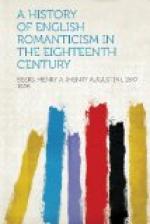[1] “Fragments of Ancient Poetry collected in the Highlands of Scotland, and translated from the Gaelic or Erse language.” Edinburgh, MDCCLX. 70 pp.
[2] This was sent him by MacPherson and was a passage not given in the “Fragments.”
[3] From “Carthon.”
[4] Scandinavia
[5] An unconscious hexameter.
[6] From “Fingal” book ii.
[7] See the dissertation by Rev. Archibald Clerk in his “Poems of Ossian in the Original Gaelic, with a literal translation into English.” 2 vols., Edinburgh, 1870.
[8] This story as been retold, from Irish sources, in Dr. R. D. Joyce’s poem of “Deirdre,” Boston, 1876.
[9] See “Leabhar na Feinne, Heroic Gaelic Ballads, Collected in Scotland, chiefly from 1512 to 1871. Arranged by J. F. Campbell,” London, 1872. Selections from “The Dean of Lismore’s Book” were edited and published at Edinburgh in 1862, by Rev. Thomas MacLauchlan, with a learned introduction by Mr. W. F. Skene.
[10] Article on “Celtic Literature” in the “Encyclopedia Britannica.”
[11] “Aspects of Poetry,” by J. C. Shairp, 1872, pp. 244-45 (American Edition).
[12] Appendix to the Preface to the Second Edition of “Lyrical Ballads.” Taine says that Ossian “with Oscar, Malvina, and his whole troop, made the tour of Europe; and, about 1830, ended by furnishing baptismal names for French grisettes and perruquiers.”—English Literature, Vol. II. p. 220 (American Edition).
[13] The Committee found that Gaelic poems, and fragments of poems, which they had been able to obtain, contained often the substance, and sometimes the “literal expression (the ipsissima verba)” of passages given by MacPherson. “But,” continues the “Report,” “the Committee has not been able to obtain any one poem the same in title and tenor with the poems published by him. It is inclined to believe that he was in use to supply chasms and to give connection, by inserting passages which he did not find; and to add what he conceived to be dignity and delicacy to the original composition, by striking out passages, by softening incidents, by refining the language: in short, by changing what he considered as too simple or too rude for a modern ear.”
[14] “Dissertation on the Authenticity of the Poems.” See ante, p. 313.




